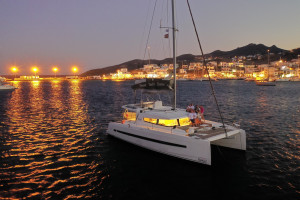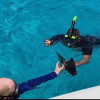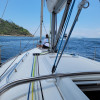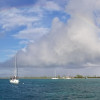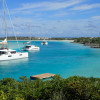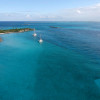The thought of hopping on board a $500,000+ yacht in Saint Lucia and setting sail for Grenada with only a couple of your somewhat reckless drinking buddies may sound like a bit much! If you’ve never done it before, it would certainly be a disaster. So how do you go from having never sailed to getting a charter company to turn over the keys?
The answer isn’t that simple. The bare minimum you’ll need is pretty shocking. Just take a few classes and rent a boat! What I would recommend is a bit more extensive, but even so, you’re much closer to being the captain of a bareboat charter than you probably think!
The Requirements
Most charter companies will give you some kind of boat once you pass a few classes. Like PADI, NAUI, and SSI for scuba certifications, the ASA (American Sailing Association) and US Sailing are two large organizations that govern the certification process in the United States. You’ll find other great training organizations like RYA (Royal Yachting Association) in the US and abroad, and I’m sure there are others.
I personally used ASA because the local sailing school was an ASA school. I’d recommend finding out what schools around you use, pick a certifying body, and stick with it until you have your certifications.
For ASA and US Sailing, the path to becoming “bareboat certified” are virtually identical.
- ASA 101 Basic Keelboat Sailing or US Sailing Basic Keelboat Certification
- ASA 103 Basic Coastal Cruising or US Sailing Basic Cruising Certification
- ASA 104 Bareboat Cruising or US Sailing Bareboat Cruising Certification
That’s it! Take and pass those classes, and one of the large charter organizations will probably give you a boat that you’ll be responsible for returning in one piece!
A quick word of warning: Some sailing schools will allow you to take 101, 103, and 104 in a single week. I don’t recommend that approach if you want to charter your own boat. Sailing is more about practice than cramming. Much of the courses are redundant, and having a month+ break between classes gives you a chance to forget and relearn skills and terms. Cramming it all into a single week is efficient, but not very effective.
Recommendation
To be able to charter a boat safely, you’ll need practice. There are dozens of systems, thousands of terms, and more ways to screw up a charter than you can imagine. If you ram into a dock, drag your anchor, run aground, or get lost out to sea, chartering will suck.
Here is a list of things I recommend if you want to get ready to charter a boat.
Take all the classes above in different locations and a month or more apart.
When you bareboat charter, you’ll probably be in a new marina and possibly country. Don’t let yourself get comfortable with your local marina and then be petrified when you arrive somewhere totally different.
Give yourself time to forget. You’ll study like crazy to learn knots, points of sail, names of rigging, etc. After a month of not thinking about it, you’ll forget a lot. When you take 103, they’ll force you to relearn all of those items, forget them again, and relearn them for 104. Hopefully, the third time’s a charm, and most of it will be burned into your memory.
Take the classes in areas that are similar or more difficult than where you want to charter.
It’s easy to get focused on the certifications. Maybe you can just knock them all out on a local lake in a week! Then when you head to Belize to take out your first bareboat charter, you’ll figure out just how unprepared you are!
Think about where you’ll want to charter and talk to people who have done it before. If you don’t know anyone personally, ask on charter forums, or ask your instructor about the location you’re considering. Some locations, like BVI, are pretty easy to charter in. The water is deep, mooring buoys are everywhere, and you’re never more than a couple of miles from land. Others can be very technical with shifting sand bars, reefs, coral heads, busy harbors, Mediterranean mooring, and terrible charts. Make sure the training you’re getting is preparing you for your future charter.
Personal Note: I did 101 on a lake in Dallas, 103 in Florida on the gulf, and 104 on a trip from LA to Catalina Island in the Pacific. Each experience was DRASTICALLY different. In Dallas, the winds constantly shifted on the lake with my J22. In Florida, I had a larger boat and a draw bridge to get in and out of the harbor. In California, we had massive Pacific swells and used a mooring buoy style I’d never seen (bow and stern attachment points with a pick-up stick).
Do some day sails.
All of the sailing schools I’ve been to have boats for rent by the day. You can rent a boat, with or without a skipper, and sail. Spend the day practicing what you’ve learned during your classes. Try every point of sail, tack, gybe, anchor, heave to, and try not to crap your pants when you dock! Try to find boats that are similar to what you’ll want to charter. Don’t keep renting a 30’ monohull if you’re planning to rent a 40’ catamaran. Practice on anything is better than nothing, but shoot to get some shorter sails on boats similar to what you’ll charter. The more time you spend on a boat, the more comfortable you’ll become.
Bareboat as a crewmember
My first experience sailing was as a crew member (if I could have even been called that) on a charter trip with some friends in the BVI. I didn’t know jack about boats, sailing, or chartering. By the end of that first week, I could tack, gybe, pick up mooring buoys, anchor, etc. I learned it because I wanted to help, and I needed to!
Not everyone has friends that bareboat charter. If you fall into that camp, you may consider doing a charter where you just pay for a cabin or a charter where you pay for a captain. You’ll be on a boat with people you don’t know, but you’ll have someone knowledgeable around, and they’ll be responsible for the boat. Boat people are always excited to share their knowledge and experiences, so you’ll have a week or more to pick your captain’s brain! You’ll pick a lot up when you're forced to crew on a boat in the destination you hope to bareboat charter in.
Find a good crew
Your first bareboat charter as captain is going to be scary as hell. You are now responsible for the crew and the vessel. Your ass is on the line, and there’s no way to prepare for that feeling! Ideally, you’ll have a competent crew, handy around boats, helpful, and who get along. These are working trips, and they need to be prepared to help with EVERYTHING. You’ll be stuck at the helm a lot, so you can’t also be putting out the fenders, tossing dock lines, dropping anchor, etc. You need a group that has some experience and a desire to help and learn.
Consider a flotilla
Many charter companies organize groups of boats that want to travel together. These flotillas have a lead boat with an experienced captain who can give navigational guidance and provide support throughout the charter. For an inexperienced captain, having a helping hand in neighboring boats could provide the peace of mind that gets you on the water safely.
Read and prepare
There are articles galore on what to bring, pack, and provision. In this post, I’m not going to go into what and how to provision, but needless to say, it’s complicated, important, and destination dependent. You don’t want to show up in the Exumas expecting to eat your meals ashore or to pick up ice every day. Make sure you have a plan for food, drinks, ice, water, and trash for every day you’ll be out. No one wants to drink warm beer, and if you run out of beer…MUTINY!
Conclusion
Bareboat chartering is an amazing experience. While you can knock out a few classes and rent a boat, you’ll likely want to do a bit more preparation than that! Get as much relevant experience as possible, plan your trip, and start enjoying the world of bareboat chartering!!

